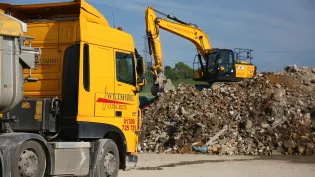Mastering the Chill: Tips for Concreting in Cold Weather

Concreting during cold weather in the UK can be challenging due to unpredictable temperatures, frost, and frequent freeze-thaw cycles. Proper preparation and methods are essential to achieve durable, high-quality concrete even in winter conditions.
Why Does Cold Weather Affect Concrete?
Concrete hardens through a chemical reaction called hydration, which depends on temperature. When concrete temperatures drop below 2°C, hydration slows, delaying the setting and curing process. If temperatures fall below freezing, water within the concrete mix may freeze, leading to:
- Increased Porosity: Frozen water expands, creating voids that reduce strength and durability.
- Surface Damage: Freeze-thaw cycles can cause scaling or spalling, especially for outdoor concrete.
- Reduced Lifespan: Poor curing in cold weather may compromise long-term performance.
Best Practices for Cold Weather Concreting
1. Adapt Your Concrete Mix
- Air-Entraining Admixtures
Introduce tiny air bubbles into the concrete to improve resistance to freeze-thaw cycles. This is particularly useful for UK winters with frequent temperature fluctuations. - Lower the Water-to-Cement Ratio
Reducing the water content creates a denser, more durable concrete mix, minimising ice formation risks. - Use Supplementary Cementitious Materials
Incorporate materials like GGBS (Ground Granulated Blast-Furnace Slag) or fly ash to enhance durability. Note: these materials may slow early strength gain, so adjustments may be needed in colder conditions. - Use Weathermix for Enhanced Durability
Weathermix is specially formulated for cold weather, providing greater resistance to freeze-thaw cycles and reducing curing delays. This is an ideal choice for UK conditions.
2. Prepare Your Site
- Preheat Materials
Use warm water or aggregates to raise the concrete mix temperature. This is vital for achieving early strength gains during frosty UK winters. - Ensure Sub-Bases and Formwork Are Frost-Free
Frost on sub-bases or formwork can lead to uneven curing. Insulate or preheat these areas to prevent rapid cooling of the concrete. - Plan Around the Weather
Avoid pouring concrete late in the day to minimise exposure to freezing overnight temperatures.
3. Protect the Concrete Post-Pouring
- Insulate After Placement
Cover the freshly poured concrete with insulating blankets or heated enclosures to maintain consistent curing temperatures. - Use Curing Compounds
Retain moisture and protect the concrete surface with curing agents suitable for UK weather conditions. - Allow Extra Time for Curing
Cold weather slows down the curing process. Ensure sufficient time before removing formwork or applying loads.

Managing Freeze-Thaw Risks
In the UK, frequent freeze-thaw cycles can damage outdoor concrete. To minimise this:
- Ensure proper drainage to prevent standing water that could freeze and expand.
- Use surface sealers to protect against moisture ingress.
- For decorative or exposed finishes, specify concrete mixes with enhanced frost resistance.
Top Tips for Cold Weather Concreting in the UK
- Monitor Temperatures: Ensure the ambient temperature is above 2°C during pouring and curing.
- Be Prepared: Keep insulation materials and curing blankets on hand during winter projects.
- Adjust Scheduling: Work during the warmest part of the day, avoiding late afternoons or evenings.
- Use the Right Mix: Opt for air-entrained concrete or other weather-adapted solutions.
To summarise
With careful planning and adherence to best practices, concreting in cold weather across the UK can yield excellent results. Implementing these strategies ensures a durable and high-quality finish, ready to withstand the British climate.
For more advice on concrete practices and products, get in touch with our experts today.
FAQ
It’s not recommended to pour concrete when temperatures are below freezing unless proper precautions, such as heating, are in place.
Concrete cures more slowly in cold weather, often requiring extended curing periods to reach sufficient strength.
Freezing can halt hydration, leading to weaker, porous concrete with reduced durability.
Weathermix is a specialised concrete mix designed for cold-weather applications. It ensures faster setting times and enhanced durability in low temperatures.
Absolutely! Weathermix is ideal for outdoor applications, offering excellent resistance to freeze-thaw cycles.




























